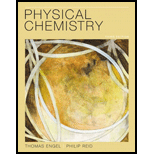
Physical Chemistry Plus Mastering Chemistry With Etext -- Access Card Package (3rd Edition) (engel Physical Chemistry Series)
3rd Edition
ISBN: 9780321766205
Author: Thomas Engel, Philip Reid
Publisher: PEARSON
expand_more
expand_more
format_list_bulleted
Question
Chapter 7, Problem 7.21NP
Interpretation Introduction
Interpretation:
The temperature at which the slope of the Z versus P curve as P tends to zero have its maximum value for a Van der Waals gasand the value of the maximum slope needs to be determined.
Concept Introduction:
The compressibility factor(Z) is the deviation of the real gas from the ideal behavior. It is also known as compression factor or gas deviation factor.
For an ideal gas,
Here, P is pressure, V is volume, n is number of moles, R is Universal gas constant and T is temperature.
Expert Solution & Answer
Want to see the full answer?
Check out a sample textbook solution
Students have asked these similar questions
Please help me solve this reaction.
Indicate the products obtained by mixing 2,2-dimethylpropanal with acetaldehyde and sodium ethoxide in ethanol.
Synthesize 2-Ethyl-3-methyloxirane from dimethyl(propyl)sulfonium iodide using the necessary organic or inorganic reagents. Draw the structures of the compounds.
Chapter 7 Solutions
Physical Chemistry Plus Mastering Chemistry With Etext -- Access Card Package (3rd Edition) (engel Physical Chemistry Series)
Ch. 7 - Prob. 7.1CPCh. 7 - Prob. 7.2CPCh. 7 - Prob. 7.3CPCh. 7 - Prob. 7.4CPCh. 7 - Prob. 7.5CPCh. 7 - Prob. 7.6CPCh. 7 - Prob. 7.7CPCh. 7 - Prob. 7.8CPCh. 7 - Prob. 7.9CPCh. 7 - Prob. 7.10CP
Ch. 7 - Prob. 7.11CPCh. 7 - Prob. 7.12CPCh. 7 - Prob. 7.13CPCh. 7 - Prob. 7.14CPCh. 7 - Prob. 7.15CPCh. 7 - Prob. 7.16CPCh. 7 - Prob. 7.17CPCh. 7 - Prob. 7.18CPCh. 7 - Prob. 7.19CPCh. 7 - Prob. 7.20CPCh. 7 - Prob. 7.1NPCh. 7 - Prob. 7.2NPCh. 7 - Prob. 7.3NPCh. 7 - Prob. 7.4NPCh. 7 - Prob. 7.5NPCh. 7 - Prob. 7.6NPCh. 7 - Prob. 7.7NPCh. 7 - Prob. 7.8NPCh. 7 - Prob. 7.9NPCh. 7 - Prob. 7.10NPCh. 7 - Prob. 7.11NPCh. 7 - Prob. 7.12NPCh. 7 - Prob. 7.13NPCh. 7 - Prob. 7.14NPCh. 7 - Prob. 7.15NPCh. 7 - Prob. 7.16NPCh. 7 - Prob. 7.17NPCh. 7 - Prob. 7.18NPCh. 7 - Prob. 7.19NPCh. 7 - Prob. 7.20NPCh. 7 - Prob. 7.21NPCh. 7 - Prob. 7.22NPCh. 7 - Prob. 7.23NPCh. 7 - Prob. 7.24NPCh. 7 - Prob. 7.25NPCh. 7 - Prob. 7.26NPCh. 7 - Prob. 7.27NPCh. 7 - Prob. 7.28NP
Knowledge Booster
Similar questions
- Synthesize 2-Hydroxy-2-phenylacetonitrile from phenylmethanol using the necessary organic or inorganic reagents. Draw the structures of the compounds.arrow_forwardSynthesize N-Methylcyclohexylamine from cyclohexanol using the necessary organic or inorganic reagents. Draw the structures of the compounds.arrow_forwardSynthesize N-Methylcyclohexylamine from cyclohexanol using the necessary organic or inorganic reagents. Draw the structures of the compounds.arrow_forward
- If possible, please provide the formula of the compound 3,3-dimethylbut-2-enal.arrow_forwardSynthesize 1,4-dibromobenzene from acetanilide (N-phenylacetamide) using the necessary organic or inorganic reagents. Draw the structures of the compounds.arrow_forwardIndicate the products obtained by mixing (3-oxo-3-phenylpropyl)triphenylphosphonium bromide with sodium hydride.arrow_forward
- We mix N-ethyl-2-hexanamine with excess methyl iodide and followed by heating with aqueous Ag2O. Indicate the major products obtained.arrow_forwardIndicate the products obtained by mixing acetophenone with iodine and NaOH.arrow_forwardIndicate the products obtained by mixing 2-Propanone and ethyllithium and performing a subsequent acid hydrolysis.arrow_forward
- Indicate the products obtained if (E)-2-butenal and 3-oxo-butanenitrile are mixed with sodium ethoxide in ethanol.arrow_forwardQuestion 3 (4 points), Draw a full arrow-pushing mechanism for the following reaction Please draw all structures clearly. Note that this intramolecular cyclization is analogous to the mechanism for halohydrin formation. COH Br + HBr Brarrow_forwardIndicate the products obtained if 2,2-dimethylpropanal and acetaldehyde are mixed with sodium ethoxide in ethanol.arrow_forward
arrow_back_ios
SEE MORE QUESTIONS
arrow_forward_ios
Recommended textbooks for you
 ChemistryChemistryISBN:9781305957404Author:Steven S. Zumdahl, Susan A. Zumdahl, Donald J. DeCostePublisher:Cengage Learning
ChemistryChemistryISBN:9781305957404Author:Steven S. Zumdahl, Susan A. Zumdahl, Donald J. DeCostePublisher:Cengage Learning ChemistryChemistryISBN:9781259911156Author:Raymond Chang Dr., Jason Overby ProfessorPublisher:McGraw-Hill Education
ChemistryChemistryISBN:9781259911156Author:Raymond Chang Dr., Jason Overby ProfessorPublisher:McGraw-Hill Education Principles of Instrumental AnalysisChemistryISBN:9781305577213Author:Douglas A. Skoog, F. James Holler, Stanley R. CrouchPublisher:Cengage Learning
Principles of Instrumental AnalysisChemistryISBN:9781305577213Author:Douglas A. Skoog, F. James Holler, Stanley R. CrouchPublisher:Cengage Learning Organic ChemistryChemistryISBN:9780078021558Author:Janice Gorzynski Smith Dr.Publisher:McGraw-Hill Education
Organic ChemistryChemistryISBN:9780078021558Author:Janice Gorzynski Smith Dr.Publisher:McGraw-Hill Education Chemistry: Principles and ReactionsChemistryISBN:9781305079373Author:William L. Masterton, Cecile N. HurleyPublisher:Cengage Learning
Chemistry: Principles and ReactionsChemistryISBN:9781305079373Author:William L. Masterton, Cecile N. HurleyPublisher:Cengage Learning Elementary Principles of Chemical Processes, Bind...ChemistryISBN:9781118431221Author:Richard M. Felder, Ronald W. Rousseau, Lisa G. BullardPublisher:WILEY
Elementary Principles of Chemical Processes, Bind...ChemistryISBN:9781118431221Author:Richard M. Felder, Ronald W. Rousseau, Lisa G. BullardPublisher:WILEY

Chemistry
Chemistry
ISBN:9781305957404
Author:Steven S. Zumdahl, Susan A. Zumdahl, Donald J. DeCoste
Publisher:Cengage Learning

Chemistry
Chemistry
ISBN:9781259911156
Author:Raymond Chang Dr., Jason Overby Professor
Publisher:McGraw-Hill Education

Principles of Instrumental Analysis
Chemistry
ISBN:9781305577213
Author:Douglas A. Skoog, F. James Holler, Stanley R. Crouch
Publisher:Cengage Learning

Organic Chemistry
Chemistry
ISBN:9780078021558
Author:Janice Gorzynski Smith Dr.
Publisher:McGraw-Hill Education

Chemistry: Principles and Reactions
Chemistry
ISBN:9781305079373
Author:William L. Masterton, Cecile N. Hurley
Publisher:Cengage Learning

Elementary Principles of Chemical Processes, Bind...
Chemistry
ISBN:9781118431221
Author:Richard M. Felder, Ronald W. Rousseau, Lisa G. Bullard
Publisher:WILEY